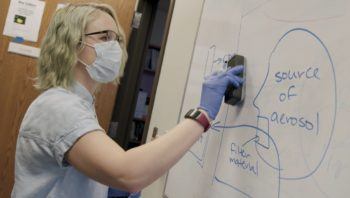What Not To Wear: Texas A&M Experts Evaluate DIY Mask Materials

Are cloth masks effective in blocking the transmission of COVID-19? Scientists at Texas A&M University are testing a variety of popular DIY mask materials to give consumers fact-based information on mask options.
“We are conducting a study evaluating a wide range of household materials as resources for constructing DIY face masks,” said Sarah D. Brooks, director of Texas A&M University’s Center for Atmospheric Chemistry and the Environment (CACE) and professor in the Department of Atmospheric Sciences in the College of Geosciences.
“In this situation people around the world have started making their own face masks from ordinary materials,” she said. “However, many people question the effectiveness of a DIY cloth mask in blocking transmission of the SARS-CoV-2 virus known to cause COVID-19.”
Using aerosol counting and sizing equipment in Brooks’ lab, the team tested the materials by producing airborne samples of non-biological surrogate particles and measuring the concentration before and after passing the sample air through the materials of interest.
Brooks led the study with collaborators Michael R. Moreno, director of innovation for engineering medicine and J. Mike Walker ’66 faculty fellow, and atmospheric sciences graduate students Jessica Mirrielees* and Bo Chen.
In Brooks’ laboratory in the Department of Atmospheric Sciences, the researchers tested the effectiveness of high-quality N95 respirators, which were completely effective, and compared the effectiveness of masks made of household materials.
“Effective face protection must fit snugly around the mouth and nose, and must be made of appropriate materials,” Brooks said. “Our results show that while a standard bandana provides some protection, certain household materials, including room air filters and vacuum bags, are more effective at blocking the virus’s passage through a mask. However, many other household materials do not provide additional filtering capability. In summary, make your cloth masks, but stitch a layer of either of these into its lining, and you may have a mask with much better filtering capability and better protection against transmission of the virus.”
View the full list of materials and their effectiveness on the CACE website, where the researchers plan to provide updated information as they continue testing various materials this month.
* This link is no longer active and has been removed.
Media contacts:
- Leslie Lee, College of Geosciences, leslielee@tamu.edu
- Robyn Blackmon, College of Geosciences, robynblackmon@tamu.edu



